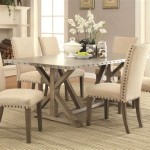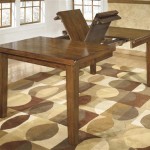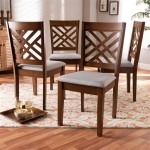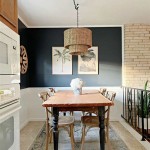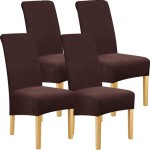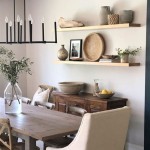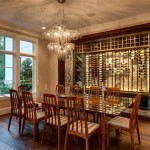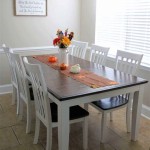Elevating Your Dining Room: A Guide to Dining Room Table Wall Art
The dining room serves as more than just a space for eating; it is a central gathering place for families and friends, a site for shared experiences, and a reflection of personal style. The dining room table often takes center stage, but the walls surrounding it present a significant opportunity to enhance the room's aesthetic. Thoughtfully chosen dining room table wall art can transform a mundane space into a visually appealing and engaging environment. This guide explores the considerations, options, and strategies for selecting the perfect wall art to complement your dining room table and overall dining room design.
Understanding the Importance of Scale and Proportion
One of the foundational principles of interior design is achieving a harmonious balance between different elements within a space. When selecting wall art for above a dining room table, scale and proportion are paramount. The artwork should neither overwhelm the table and the surrounding area nor appear insignificant and lost on the wall. Several factors influence the appropriate size of the artwork.
First, consider the dimensions of the dining room table. A large, expansive table can accommodate a larger, more impactful piece of art, while a smaller, more intimate table may call for a smaller, more subdued artwork. A helpful guideline is to ensure the artwork's width is approximately two-thirds to three-quarters the width of the table. This proportion prevents the artwork from appearing either too dominant or too diminutive.
Second, the height of the ceiling plays a crucial role. In rooms with high ceilings, vertical artwork or a gallery wall arrangement can visually fill the space and prevent the room from feeling empty or disproportionate. Conversely, in rooms with lower ceilings, horizontal artwork can create a sense of spaciousness and elongate the wall. Ensuring there is adequate space between the top of the table and the bottom of the artwork is equally important; a minimum of 12-18 inches is generally recommended to avoid a cluttered or cramped feeling.
Third, the surrounding furniture and décor must be considered. If the dining room already features bold colors, patterns, or textures, the artwork should complement these elements without competing for attention. A simpler, more minimalist artwork might be appropriate in such a scenario. Alternatively, if the dining room has a more neutral or understated design, the artwork can serve as a focal point and introduce visual interest.
Exploring Different Styles and Themes
The style and theme of the wall art should align with the overall aesthetic of the dining room. This consistency ensures that the artwork contributes to a cohesive and harmonious design. There is an extensive range of styles and themes available, each offering a unique ambiance and visual appeal.
For a traditional dining room, classic paintings, landscapes, or still life compositions can add a touch of elegance and sophistication. Framed prints with ornate details and rich colors can further enhance the traditional feel. Consider artists and styles that resonate with the period and character of the room's architecture and furniture.
In a modern or contemporary dining room, abstract art, geometric patterns, or minimalist designs can create a sleek and sophisticated look. Bold colors, clean lines, and unconventional materials can add a sense of visual interest and personality. Photography, especially black and white or highly stylized images, can also be a fitting choice for modern spaces. Metal wall art can introduce a contemporary industrial feel.
For a rustic or farmhouse-style dining room, nature-inspired artwork, vintage prints, or hand-painted signs can evoke a sense of warmth and charm. Landscapes, botanical illustrations, or images of rural life can complement the natural elements of the room. Artwork made from reclaimed wood or other natural materials can further enhance the rustic aesthetic.
If the dining room has a more eclectic or bohemian vibe, consider incorporating a mix of different styles and themes. This approach allows for greater creativity and self-expression. Don't be afraid to combine unexpected elements, such as vintage posters, tribal tapestries, and modern abstract art. The key is to create a visually engaging and harmonious composition that reflects the homeowner's unique personality.
Beyond these broad categories, consider thematic elements that relate to dining and food. Still life paintings featuring fruits, vegetables, or culinary items can be a classic and appropriate choice. Quotes related to food, family, or togetherness can also add a personal and meaningful touch. However, avoid overly literal or cliché themes, as these can detract from the overall sophistication of the room.
Optimizing Placement and Arrangement
The placement and arrangement of wall art are crucial for achieving the desired visual effect. Proper placement can enhance the impact of the artwork and create a focal point in the dining room. Several factors should be considered when determining the optimal placement.
First, the height of the artwork is important. As mentioned earlier, the bottom of the artwork should be at least 12-18 inches above the dining room table. This spacing ensures that the artwork is visible and accessible without feeling cramped. The center of the artwork should ideally be at eye level, which is typically around 57-60 inches from the floor. This height ensures that the artwork is easily viewed and appreciated by guests.
Second, the spacing between multiple pieces of artwork is crucial. If creating a gallery wall or hanging a series of artworks, maintaining consistent spacing between each piece is essential for a cohesive look. A spacing of 2-4 inches is generally recommended, but this can be adjusted based on the size and style of the artwork. Consider using a level and measuring tape to ensure that the artwork is hung straight and evenly spaced.
Third, the lighting in the dining room should be considered. Natural light can enhance the colors and details of the artwork, while artificial light can create a dramatic or moody effect. Ensure that the artwork is adequately illuminated to prevent shadows or glare. Consider using spotlights or track lighting to highlight specific pieces of artwork. Reflecting the light off of shiny frames or glass can create unwanted distractions. Matte finishes may be preferred.
Fourth, the surrounding wall space should be taken into account. If the wall is narrow or cluttered, a single, prominent piece of artwork may be the best choice. If the wall is large and open, a gallery wall or a triptych (a set of three related artworks) can create a more impactful statement. Consider the overall balance and symmetry of the room when arranging the artwork.
When arranging a gallery wall, start by laying out the artwork on the floor to experiment with different configurations. Consider the size, shape, and color of each piece, and try to create a visually balanced and harmonious composition. Use a template to mark the placement of each nail or hook on the wall before hanging the artwork. Remember to consider the eye level when planning the arrangement.
Beyond traditional hanging methods, consider alternative ways to display wall art. Leaning artwork against the wall on a shelf or ledge can create a more casual and relaxed look. This approach is particularly effective for larger pieces of artwork that may be difficult to hang. Similarly, using decorative easels to display artwork can add a touch of elegance and sophistication.
Materials and Framing Considerations
The materials and framing of the wall art can significantly impact its overall appearance and durability. Choosing the right materials and framing can enhance the artwork's aesthetic appeal and ensure that it lasts for years to come. Several factors should be considered when selecting materials and framing.
First, the type of artwork should influence the choice of materials. Paintings on canvas typically require a different type of framing than prints on paper. Canvas paintings often benefit from stretcher bars, which provide support and prevent the canvas from sagging. Prints on paper may require a mat board and a frame to protect them from damage and enhance their appearance.
Second, the style of the artwork should be considered when selecting a frame. A traditional painting may benefit from an ornate, gilded frame, while a modern print may look best in a simple, minimalist frame. The frame should complement the artwork without overpowering it. Consider the color, material, and finish of the frame to ensure that it harmonizes with the artwork and the surrounding décor.
Third, the quality of the materials is crucial. Use archival-quality materials, such as acid-free mat board and UV-protective glass, to prevent the artwork from fading or deteriorating over time. Avoid using cheap or flimsy frames, as these can detract from the artwork's appearance and provide inadequate protection. Investing in high-quality materials will ensure that the artwork remains in excellent condition for many years.
Fourth, consider the placement of the artwork when selecting materials. If the artwork is located in a high-humidity area, such as a kitchen or bathroom, choose materials that are resistant to moisture and mold. Acrylic frames are a good option for such environments, as they are lightweight, durable, and resistant to water damage. Similarly, if the artwork is exposed to direct sunlight, use UV-protective glass to prevent fading.
Fifth, consider the environmental impact of the materials. Choose sustainable and eco-friendly materials whenever possible. Recycled wood frames, organic cotton canvas, and water-based paints are all good options. By making conscious choices about materials, the homeowner can reduce their environmental footprint and support sustainable practices.
Finally, the budget should be considered when selecting materials and framing. While it is important to invest in high-quality materials, it is also possible to find affordable options that meet your needs. Shop around and compare prices before making a purchase. Consider framing the artwork yourself to save money. DIY framing can be a fun and rewarding project, but it requires some skill and attention to detail.
Integrating Wall Art with Other Dining Room Elements
Wall art does not exist in isolation. To truly elevate the dining room, it must integrate seamlessly with other elements, such as lighting, furniture, and textiles. A holistic approach to design ensures that the room feels cohesive and well-considered.
The color palette of the room is a key element to consider. The colors in the artwork should complement the colors of the walls, furniture, and accessories. A monochromatic color scheme, where different shades of the same color are used, can create a calming and sophisticated look. A complementary color scheme, where colors that are opposite each other on the color wheel are used, can create a more vibrant and dynamic look. A harmonious color scheme, where colors that are next to each other on the color wheel are used, can create a balanced and cohesive look.
The texture of the artwork should also be considered. If the room already features a lot of smooth surfaces, such as glass or metal, consider adding artwork with a more tactile texture, such as a textured canvas or a woven tapestry. This contrast can add visual interest and prevent the room from feeling too sterile. Conversely, if the room already features a lot of textured surfaces, such as brick or stone, consider adding artwork with a smoother texture, such as a glossy print or a lacquered painting.
The lighting in the dining room can be used to highlight the artwork and create a specific mood. Dimmable lights can be used to create a more intimate and romantic atmosphere, while bright lights can be used to create a more energetic and lively atmosphere. Consider using spotlights or track lighting to highlight specific pieces of artwork. Make sure that the lighting is positioned so that it does not create glare or cast unwanted shadows.
The furniture in the dining room should also complement the artwork. The style of the furniture should be consistent with the style of the artwork. For example, if the artwork is modern, the furniture should also be modern. The scale of the furniture should also be appropriate for the size of the artwork. A large piece of artwork may require larger pieces of furniture to balance it out. Consider the overall layout of the room and make sure that the furniture is arranged in a way that allows the artwork to be easily viewed.
Finally, the textiles in the dining room should also be considered. The colors, patterns, and textures of the textiles, such as curtains, rugs, and tablecloths, should complement the artwork. For example, if the artwork features a lot of floral patterns, consider using curtains or a tablecloth with a similar floral pattern. The textiles can also be used to add a pop of color or texture to the room.
:strip_icc()/127107347_378909933559802_5209338986625741338_n-d8e04eccf7274b2b91e5b75ec9ca40ef.jpg?strip=all)
29 Dining Room Wall Décor Ideas

Dining Room Wall Decor Kitchen Prints The Best Memories Are Made Gathered Around Table Farmhouse Printable Art Etsy

20 Ways To Dress Up Dining Room Walls Wall Decor Hgtv

The Best Memories Are Made Gathered Around Table Modern Farmhouse Wall Decor Dining Room Sign Kitchen Large Canvas Print Art Etsy

Classical Painting Wall Art Jesus Betrayal Disciples Last Dinner Fine Canvas S

25 Large Wall Art Ideas To Fill Those Blank Spaces Dining Room Scandinavian Interior Design Walls

Completed Dining Room Gallery Wall Art Sources Brepurposed

55 Dining Room Wall Decor Ideas Interiorzine

Dining Room Wall Art Ideas Inspired By Existing Projects

55 Dining Room Wall Decor Ideas Interiorzine

